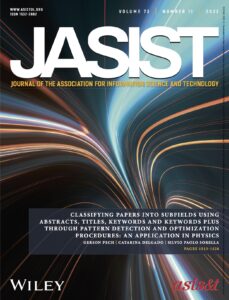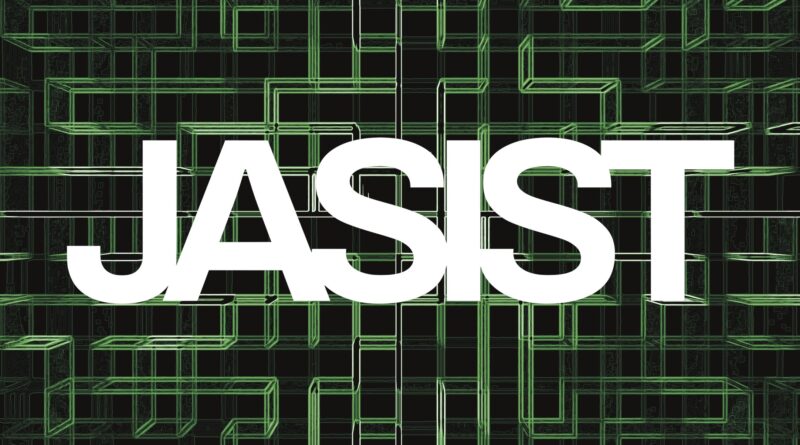JASIST Editorial Note: November 2022
JASIST Editorial Note: November 2022
Introducing the Advisory Board, and Thoughts on Submitting Manuscripts to JASIST
Steve Sawyer
Two topics in this editorial update. First, I introduce and explain the Journal’s newly formed Advisory Board (AB). Second, I highlight some advice for developing a manuscript that will have a higher likelihood of thriving in peer review. This reflects a career of collecting such guidance, magnified by years of editorial work and now reinforced by current duties.
—With the addition of the AB, there are now close to 100 scholars who have a voice in the Journal’s operations, intellectual positioning, and scholarly remit—
The Advisory Board provides the Journal and the Editorial Board with outside advice and expertise. The AB’s presence will reduce pressure on the Editorial Board (EB) members to both steward reviews and provide advice. On this last point, the EB will continue to be an important source of insight and guidance for the Journal. The AB’s members will join the nearly 70 members of the Editorial Board, as well as the members of ASIS&T’s publications committee and Board of Directors, in guiding the Journal.
This background provided, with great excitement and profound thanks, here are the 13 scholars who have agreed to join the Advisory Board:
Sourav Bhowmick, Nanyang Technological University
Maria Bonn, UIUC
Yi Bu, Peking University
Lisa Given, RMIT University, ARIST Editor-in-Chief
Preben Hansen, Stockholm University
Caroline Haythornthwaite, Emeriti, Syracuse University
Matt Lease, The University of Texas at Austin
Liz Liddy, Emeriti, Syracuse University
Gary Marchionini, UNC at Chapel Hill
Lydia Middleton, ASIS&T
Javed Mostafa, UNC Chapel Hill, previous JASIST Editor-in Chief
Chirag Shah, The University of Washington, Information Matters Editor-in Chief
Cassidy Sugimoto, Georgia Tech.
Many of these AB members have extensive publishing experience, and many also have extensive experience with JASIST. There are also scholars on the AB from around the globe and at varying stages of their careers. Likewise, the AB features the editor-in-chiefs of other ASIS&T publications like ARIST and Information Matters as well as ASIS&T’s executive director. The Journal aims to grow and diversify the AB, with the goal of a sustained membership of about 20 and the expectation that AB members will serve three to five years. If you are interested in serving on the AB, please contact me directly to explain your interests, how you will help diversify the AB’s membership, and how you can contribute to the Journal.
With the addition of the AB, there are now close to 100 scholars who have a voice in the Journal’s operations, intellectual positioning, and scholarly remit. This includes members of ASIS&T leadership, the ASIST Publications Committee, the Journal’s Editorial Board, and now the Journal’s Advisory Board. This form of shared governance works because so many of our colleagues are willing to serve the Journal, its authors, and our scholarly community.
 On the second topic of this editorial, one observation from my time as EIC is the disconnect between those who focus on publishing and those who focus on making a greater contribution with their work. A focus on publishing leads to seeing journals as containers, or a place to “put things.” Such a view neglects that each Journal is a “discourse community:” place where multiple scholarly conversations are carried on across multiple papers and over multiple years. These discourses are visible through the shared topics, concepts, theories, methods, questions and debates that characterize these scholarly engagements.
On the second topic of this editorial, one observation from my time as EIC is the disconnect between those who focus on publishing and those who focus on making a greater contribution with their work. A focus on publishing leads to seeing journals as containers, or a place to “put things.” Such a view neglects that each Journal is a “discourse community:” place where multiple scholarly conversations are carried on across multiple papers and over multiple years. These discourses are visible through the shared topics, concepts, theories, methods, questions and debates that characterize these scholarly engagements.
Papers submitted without a clear connection to the Journal’s scope or discourse rarely move past initial screening. “Desk-rejects” may or may not be indicative of the manuscript’s scholarly quality, but they are certainly a marker of poor fit in the same way that submitting an economics paper for a biology class assignment would be a topical mismatch.
In contrast, thinking of a journal as a discourse community pushes authors to read what has been published, beginning with scanning the tables of contents and exploring papers that overlap with their interests. Authors should read the Journal’s editorial statement and author guidance to learn more about community standards. Then, take a look at the publishing histories and expertise of the editorial board’s members to see if there is expertise that matches your interests, as these are the scholars who will oversee the review. If the journal seems like a good fit, then do some reviews for the journal. Doing reviews helps you learn about the discourse, and perhaps the writing styles, of the journal. To do so, contact the journal’s editor to offer your services, and provide them with a list of useful keywords or topics.
Journals like JASIST are places for multiple threads of scholarly discourse. Some threads, like the work of online reviews, are opening up. Others, like studies of search behavior, have been going on for decades and maturing. One way to find out which journals are a fit for you is to visit the journals where papers you are citing are published, then seek to publish there.
Seeing a journal as a place where the people whose papers you are citing and publishing will help you to write your work to speak to them: Write for a specific audience of scholars, and not generically. For example, framing your submission as “…building from and extending the works of several recently published papers” (and then explaining this in several sentences) shows the connection. Doing this showcases the work of connecting and extending the discourse. One “submission trick” is to cite one or two papers from the journal (often in the early part of the submission) to show that there is a connection to the discourse. This is something easily sussed out with even a modest editorial check. Engaging the discourse may only take one paper: the level of connecting between your goals and work in a journal is not a count of cites.
In my next editorial, I will continue on the theme of helping you write to thrive in peer review. Thank you for reading and please consider submitting your work to JASIST.
Steve Sawyer
Editor-in-Chief, JASIST
Professor, Syracuse University’s iSchool
Cite this article in APA as: Sawyer, S. (2022, November 18). JASIST Editorial Note: November 2022. Information Matters, Vol. 2, Issue 11. https://informationmatters.org/2022/11/jasist-editorial-note-november-2022/






